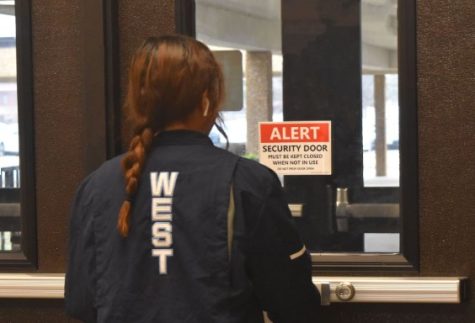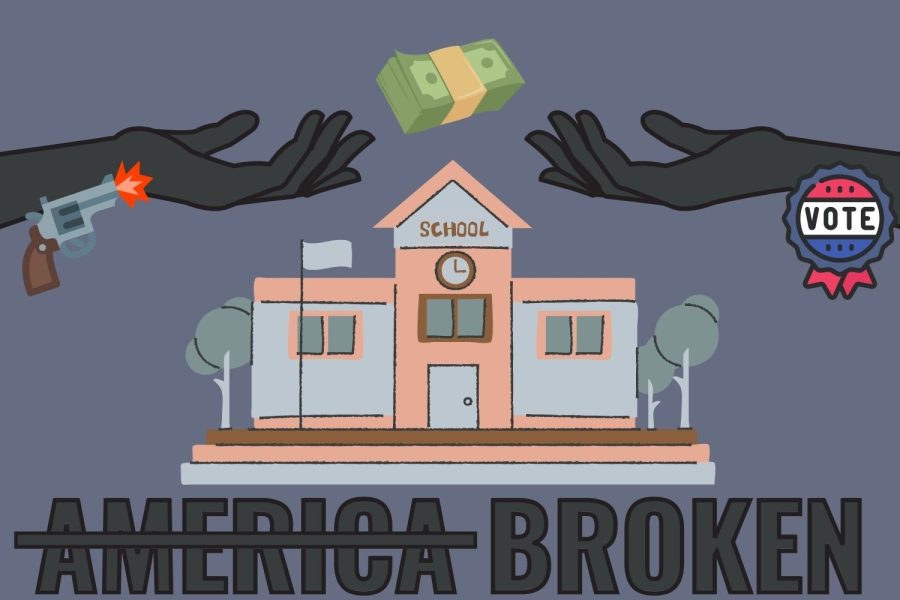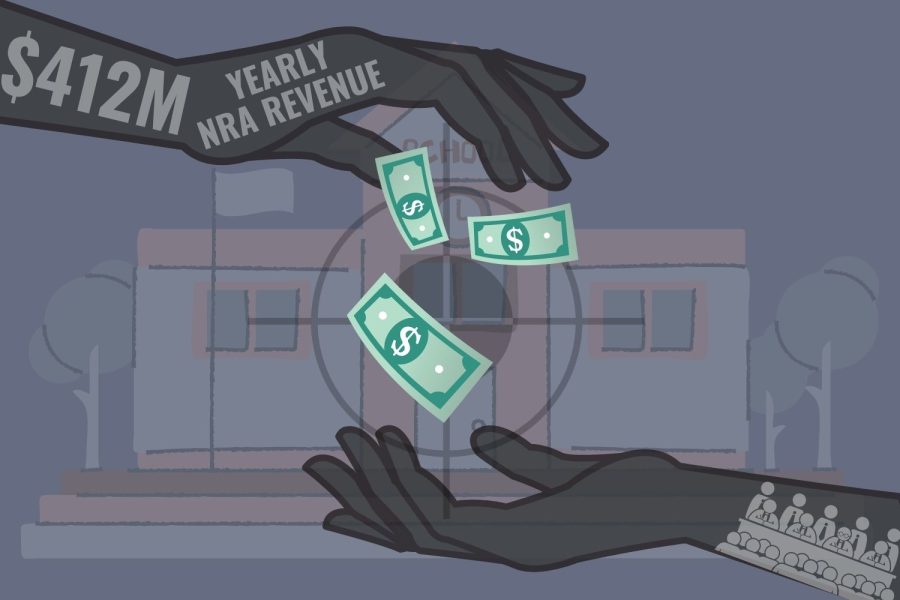On Oct. 14, West High parents received an email that notified them of a potential safety concern from the Chesterfield Police Department. In the subsequent weeks, repeated incidents of a shooter being near or on school grounds have caused the area to be on high alert. “It’s unfortunate to think I am not alone in feeling numb. We have been exposed to so much violence towards schools,” social studies teacher Kevin Doherty said. “I feel shame it took something so close to home to really open up my eyes to the extent to which this barbarity has spread.”
Guns and schools: a deep dive into America’s broken system
January 11, 2023
Content warning: This article mentions gun violence, school shootings and death.
Just 20 miles away from Parkway West, teacher Jean Kuczka and 15-year-old Alexzandria Bell were killed in the Central Visual and Performing Arts (CVPA) High School shooting. Then, a few days later, just five miles away, a bomb threat — followed by a shooting threat — rattled Marquette High School, forcing students to evacuate. A few days ago, just 10 miles away from West, Pattonville High School shut down due to a shooting at a Cracker Barrel nearby. Now, school shootings seem closer to us than ever, and there is no escape, especially for students.
After a shooting in October, threats in November, and now, school closures due to shootings in January, it is essential we continue to have conversations about school shootings until significant changes in policy, gun control or effective, long-lasting safety measures have occurred. Negligence surrounding student safety threatens our future, and while no one at Parkway West was directly put in danger because of gun violence, many of our students have been indirectly affected. Senior Emily Kerber’s cousins were at Marquette at the time of the threat.
“Marquette ended up canceling the entire week of school. It was nerve-wracking, to say the least,” Kerber said. “I had always heard school threats and shootings on the news; you really can’t miss it if you live in America. But to see it happen to my cousins so close to home, it felt different. It’s this feeling of paranoia, of feeling no one is safe.”
For the past 12 years, the United States has faced about 288 school shootings, making it the country with the highest record, followed by Mexico with eight, South Africa with six and most other countries with less than two. Despite being the most developed at the top of the list, the United States has an uncanny number of shootings, considering it is not facing volatile political conflicts like Mexico, Afghanistan or South Africa.
“You always see national coverage of big school shootings in America. But in any other country, the CVPA shooting and even the Marquette threat would have made national news because it’s not as normalized,” Kerber said.
In 2022, school shootings left 140 students killed or injured. Now, people from our community in St. Louis contribute to this horrific statistic. Kuczka and Bell were more than numbers, and failing to make systemic changes after this event would dishonor their deaths. Accordingly, it is imperative we start learning more about American policy and its inner workings, how we handle accountability for school shootings and addressing the cultural normalization of violence in our country.
Policy or diplomacy?
Missouri Senator Roy Blunt ranks third in Congress in receiving the most NRA spending, averaging about 4.6 million dollars thus far, despite 1288 gun deaths in our state annually. Josh Hawley, our second senator, ranks 12th, receiving about 1.4 million dollars from the NRA.
Only seven months ago, 19 children and two adults were brutally murdered by a school shooter at Robb Elementary School. This was the second-deadliest shooting since the 1970s. And, it worked sufficiently to excite America from its deep slumber of neglect around school shootings, even prompting conservative Texas governor Greg Abbott to publicly claim on the Texas House of Representatives’ investigative report on Robb Elementary, “We will begin working with the legislature to develop and implement the necessary changes to improve public safety, school safety and mental health assessment and treatment.”
Despite all this talk, trifling progress was made in legislation; schools were not made safer, and less severe school shootings and threats continued. In fact, this year has the highest number of school shootings, with a depressing record high of 51 compared to 35 last year.
On top of that, many politicians used this violence to further their policy, with gun advocates such as former President Donald Trump claiming murders, mass shootings and crimes wouldn’t happen to the extreme degree we have been seeing if there were enough guns for the average person, known as the “good guys.” Many politicians have extended this line of reasoning to schools, pushing for armed educators in hopes of making schools safer instead of apprehending the ones with firearms.
“It’s unfortunate we live in a society where we have to have these conversations about arming people to protect students in school,” English teacher Daniel Barnes said. “Arming teachers or trusted adults as such would do more harm than good; it would add a very ominous — and frankly, unsafe — atmosphere to the building, to see the people who are supposed to be in charge walking around with firearms.”
Barnes is not the only one who is skeptical about the supposed benefits of adding guns. Harvard professor of Health Policy David Hemenway claims “guns make hostile interactions more deadly” and overall worsen a situation. Americans already seem to understand the dangers of adding more guns, with 53% saying gun laws should be stricter than they currently are. If most Americans realize we can’t fight fire with fire, why don’t policies reflect what Americans truly want?
A darker, more nefarious reason underlies policy: rifle associations fund our politicians, effectively controlling and regulating policies to promote guns. Missouri’s senators, Josh Hawley and Roy Blunt, both conservative, have allegedly received nearly $6 million in contributions from the National Rifle Association (NRA). This is shaping our policy, at least more so than public opinion.
In Missouri alone, the Second Amendment Preservation Act, passed in July 2022, just one month after the Robb Elementary shooting, protects gun-owning rights despite Missouri having the most lenient laws among the 50 states. Missouri has no law requiring background checks, no law licensing requirements for owning a rifle, shotgun or handgun. This allows people to carry hidden, loaded handguns in public without a permit or safety training.
These policies are endangering school students and faculty to promote larger, richer organizations that, in turn, fund politicians. Students’ interests are being ignored, and the worst part is, as non-voting citizens, we have little power over regulating laws, so they reflect our interests.
“It’s important to allow students to be heard, considering they are the ones most directly impacted by school shootings,” former CVPA student-teacher and current Parkway West social studies teacher Kevin Doherty said. “Our political environment is so volatile, and often, young people especially feel like they have no impact. We need to start with a foundation of empathy and respect, from which conversations — and then hopefully actual policy — can be established.”
Even though the system works against students, bringing awareness to corrupt negotiations and the shady inner workings of the policy behind gun regulations can help voters make better, more informed decisions in the future. Students in particular can urge politicians to adopt more ethical practices by volunteering with gun-control organizations like March for Our Lives and Sandy Hook Promise. With enough nationwide support and urgency, the pressure falls upon our politicians, who need our votes.
Sadly though, this is not enough. While Americans can prepare for the future, this is not a short-term solution. Systems need to change, including being responsible about who we hold accountable.
Schools are not prisons
Often holding someone accountable has made our society safer, but in the case of school shootings, this has proven to be a complex task. With other crimes, accountability entails placing restrictions and punishments on perpetrators; with school shootings, the opposite has taken place.

In the past decade, politicians have urged reinforcing school security by “hardening” schools. Proposed methods include adding bulletproof doors and windows, metal detectors, door-locking systems and — in some cases — armed guards. At Parkway West, this entails prohibiting students from propping open doors or letting outsiders in during the school day, as well as having an onsite police officer.
“Obviously the issue of school shootings needs to be addressed on a bigger scope and with more urgency. But, for now, protecting [ourselves] is as simple as making sure doors are locked and students don’t leave the building,” Doherty said.
While basic safety measures seem reasonable, when it comes to more extreme measures like installing metal detectors or issuing bullet-proof backpacks, they seem restrictive and overbearing. A simple question arises: Why are students’ freedoms sacrificed when we can place restrictions on guns and ammunition?
Not to mention, these safety measures simply won’t suffice in the long run. CVPA had multiple safeguards, including metal detectors, at least one onsite security officer guarding doors and security cameras. Yet, on the fateful day of the shooting, the 19-year-old former CVPA student shooter was able to both enter the building and carry an AR-15-style rifle with 600 rounds of ammunition.
“I [was a student teacher] in the same building as CVPA, and there are many systems in place that protect students from intruders. Our bags were searched, and overall, the environment was very safeguarded; there are virtually no discipline issues. It’d be the last place I would ever think anything like this would happen,” Doherty said.
Despite all these safety measures in place, they failed: two people are dead, and seven were in the hospital injured. CVPA was not the only school whose safety measures failed to protect them: Door-locking systems failed Robb Elementary in Texas and monitored entrances failed Parkland High School in Florida.
“There is already a feeling of paranoia living in America as a student, especially now in St. Louis. We’ve had more than three incidents [in our area], and we are anxious about what is to come. School should feel like home, but now that is being taken away from us,” Kerber said.
School security has become a $2.7 billion business in America, and no research or hard evidence guarantees these measures are effective. In fact, hardening schools comes with its own set of negative consequences, specifically on school climate and student mental health.
Hardening techniques can make schools seem prison-like, leading to students with more mental problems and, consecutively, a higher chance of unintended violence. In addition, it hurts the development of young adults; schools with high-tech security often show correlated increased levels of fear and anxiety among students and staff. On top of that, some hardening techniques, like arming teachers, can lead to disruption in learning and an overall parlous educational environment. Cognitive biases can put certain students of color, gender or disability at a higher risk of being shot by an adult than their peers, in the facade of a safe environment.
Hardening schools is not a solution, and it is time schools employ a different technique to combat school shootings.
Mindset Matters
If arming teachers in the building, trusting policies or introducing “hardened” security measures prove to be unreliable, what else can prevent school shootings?
It is time schools give softening techniques a serious chance. Softening techniques include focusing on the emotional and social needs of students, thereby targeting the root of the problem: the mental health of would-be shooters.
“We should start asking why any individual would try to commit mass murder in a school setting, then understand that our world is so broken that individuals feel there is no hope. They feel like this is their only alternative is that they must do something so extreme to fill whatever void they’re looking to fill,” Doherty said.
A majority of students who plotted school attacks suffered from depression and anxiety from facing adverse childhood experiences, including substance abuse in the home, violence or parental incarceration. Considering the median age of school shooters is 16 years old, it is evident that these kids often lack an understanding of how to deal with their emotions in unpropitious life situations. Reaching their limit, left with no other option in their view, they turn that hate on others and often themselves, with around 34% of school shootings ending with suicide.

When surrounded by hate, you learn to be hateful, but schools can change that. They can become a beacon of hope simply by helping students — by
providing adequate counselors, mental health resources and a chance for students to be heard — learn how to be better human beings. Besides, it would also be strategic for schools to pay attention to students’ mental health as 50% of school shooters are former students of the school they attack and most had been bullied at school.By no means does understanding the viewpoint of the shooter validate their actions. Instead, softening techniques allow schools to empathize with the shooters and channel their emotions toward a productive and positive outlet.
“It has become so normalized in American society for shooters to target schools that we start feeling numb to it. It shouldn’t be that way,” Doherty said. “Certain mental health programs can help remind us that feeling anger and pain is normal, but acting on it, so violently and cruelly, is absolutely unacceptable.”
Many schools have already implemented these widely supported softening techniques, and there are many options for schools that are interested. Socio-emotional learning (SEL) programs such as Positive Action and PATHS focus on preventing violence, bullying and substance abuse by developing school-family-community relations. In addition, schools can hire more counselors, psychiatrists, psychologists and social workers to help students improve their mental health.
At Parkway West, trusted adult surveys require students to pick their adult of choice in the building. When a concern arises, administrators and counselors can use this data to ensure safe people and safe spaces available to students. In addition, counselors integrate SEL lessons into their curriculum that they present throughout the year to grade levels. Care coordinator Rebecca Morris helps organize some of these preventive steps, as well as acts as a guide to students, parents or teachers who have concerns regarding a student’s well-being.
“We are encouraged as a staff to have open, frequent communication regarding students. Teachers, administrators and counselors work collaboratively to identify students who might be struggling with mental health concerns and connect them to appropriate resources,” Morris said. “We are very lucky here at West to have a caring group of teachers who really want to get to know their students and build relationships with them. As a team, we can work with students, families and outside providers to create a comprehensive plan of support for a struggling student that includes both in-school and out-of-school support.”
In recent years, gun violence has become more common, and school shootings pose a real threat to students. Yet, as schools, parents and politicians actively scramble for solutions, they ignore both the perpetrator and the victims of these crimes: the students. Although unscrupulous politicians may favor multi-billion dollar gun companies that fund them over non-voting students, by paying attention to the emotional, social and mental needs of students, schools should become topics of bridging gaps surrounding gun control instead of building them.




Mary A. • Oct 24, 2023 at 2:31 pm
So impressed with the maturity and investigation in this article
Luisa • Feb 5, 2023 at 9:39 pm
thank you for addressing the recent problems happening in St. Louis, props to the author. just donated to sadny hook promise!
Will Gonsior • Jan 18, 2023 at 9:30 pm
Amazing story. “Softening” and gun restrictions are absolutely necessary to stay safe. Favorite line: “Why are students’ freedoms sacrificed when we can place restrictions on guns and ammunition?” People’s lives should be the most important.
Still, I would be cautious about appealing to the majority. A 53% majority favoring stricter gun laws could easily flip in time. And if it did, would we want majority-ruling politicians? No, we’d want politicians with heart enough to protect us. Which we don’t really have either way. *sigh*
A • Jan 18, 2023 at 8:42 pm
Amazing article. Really addressed the issues that we have to worry about on a daily basis.
Will • Jan 12, 2023 at 7:07 pm
Very in-depth story. As a parent, it is scary to send my kids to school. It is nice to see students addressing an issue many adults brush under the rug. Hopefully, positive action will take place soon, keeping my fingers crossed, God help America.